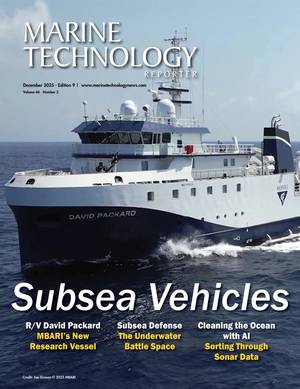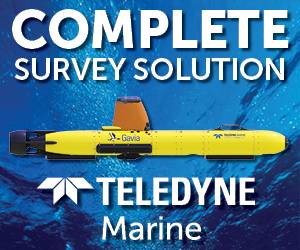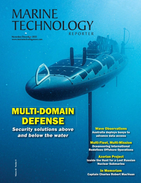
Unlocking Ocean Power: $3.6M for Community-centric Wave Energy Converters
;s HERO wave energy converter—the device hanging from the crane. It was built to remove salt from water using wave power. Photo credit: John McCord, Coastal Studies Institute, East Carolina University.Additional team members include: Danesh Tafti, professor of mechanical engineering at Virginia Tech; Daniel Deng, U-M adjunct professor of naval architecture and marine engineering and laboratory fellow at the Pacific Northwest National Laboratory; Gail Gruenwald, a member of the Beaver Island Association; and Bill Staby, founder of Blue Water Network LLC.Zuo is also a professor of mechanical
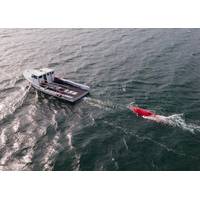
Sonardyne Suite for Dive Technologies’ AUV
autonomous underwater vehicle (AUV) program.Founded in 2018, Dive Technologies’ rapid development program has included support from the Defense Advanced Research Projects Agency (DARPA) and technology partnerships with organizations including the Center for Marine Autonomy and Robotics at Virginia Tech. A key part of the development has been to opt for high-performance, off-the-shelf systems for its DIVE-LD AUV, a 19-ft. long, 48-in. diameter vehicle designed for operations down to 6,000 m water depth. It is currently in production in the U.S. with sea testing ongoing in New Bedford.The scope
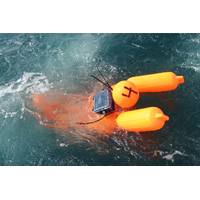
Tech Talk: Algorithm Aims to Assist Ocean Search and Rescue
directions. When an object or person goes missing at sea, the complex, constantly changing conditions of the ocean can confound and delay critical search-and-rescue operations.Now researchers at MIT, the Swiss Federal Institute of Technology (ETH), the Woods Hole Oceanographic Institution (WHOI), and Virginia Tech have developed a technique that they hope will help first responders quickly zero in on regions of the sea where missing objects or people are likely to be.The technique is a new algorithm that analyzes ocean conditions such as the strength and direction of ocean currents, surface winds, and

Shell Ocean Discovery XPRIZE Semifinalists Announced
by Dylan Blakeslee and working in partnership with successful alumni of Texas A&M; the University team is using drone ships and AUVs equipped with innovative navigation systems, renewable power generation and chemical sensing technologies to explore remote ocean habitats. Virginia DEEP-X -- Virginia Tech and Old Dominion University (Virginia, United States) – Led by Dan Stilwell, the team is developing small and low-cost underwater vehicles that operate in coordinated teams. X994 (Austin, TX, United States) – Led by David Ryan, the team is working to optimize robotic mapping
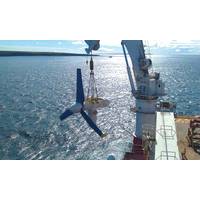
Riding the Waves and Tides to a Cleaner Energy Future
by Ocean Energy USA of Sacramento, CA. (http://energy.gov/eere/articles/energy-department-announces-10-million-full-scale-wave-energy-device-testing). Just last month, DoE awarded an additional $7.4 million to develop advanced components for wave and tidal energy systems, including awards to Virginia Tech and Penn State University. The purpose of the funding is to help improve the performance and reduce the cost of MHK technologies. (http://energy.gov/eere/articles/energy-department-awards-74-million-develop-advanced-components-wave-and-tidal-energy.) If a MHK project is located
20 Teams Vie for Wave Energy Prize
nation’s most advanced wave-making facility, the Naval Surface Warfare Center’s Maneuvering and Seakeeping (MASK) Basin at Carderock, Md., beginning in the summer of 2016. www.waveenergyprize.org Official qualified teams are: • Advanced Ocean Energy @ Virginia Tech (Hampton Roads, Va.) • AquaHarmonics (Oakland, Calif.) • Atlantic Wavepower Partnership (Newport, R.I.) • Atlas Ocean Systems (Houston, Texas) • CalWave (Berkeley, Calif.) •
Twenty Teams Vie for Wave Energy Prize
game-changing wave energy conversion (WEC) devices that will achieve the DOE’s goal of doubling energy captured, which will in turn reduce the cost of wave energy, making it more competitive with traditional energy solutions. Official qualified teams are: •Advanced Ocean Energy @ Virginia Tech (Hampton Roads, Va.) •AquaHarmonics (Oakland, Calif.) •Atlantic Wavepower Partnership (Newport, R.I.) •Atlas Ocean Systems (Houston, Texas) •CalWave (Berkeley, Calif.) •Enorasy Labs (Bedford, Mass.) •Float Inc. – BergerABAM (San Diego

Northrop Grumman Hires VP for Undersea Systems
areas were field robotics and 3D imaging systems. Lytle is also a U.S. Navy submarine officer and served on fast attack submarines before transitioning to the Navy Reserve. He currently holds the rank of captain. Lytle earned bachelor's, master's and doctorate degrees in engineering from Virginia Tech. He is also a graduate of the Naval Command and Staff program at the Naval War College

Making Sailors 'SAFFiR'
by the Office of Naval Research (ONR), walked across uneven floors, used thermal imaging to identify overheated equipment, and used a hose to extinguish a small fire in a series of experiments Nov. 3-5, 2014 aboard the USS Shadwell, a decommissioned Navy vessel. Developed by researchers at Virginia Tech, the two-legged, or bipedal, humanoid robot is helping ONR evaluate the applications of unmanned systems in damage control and inspections aboard naval vessels, supporting the autonomy and unmanned systems focus area in the Navy's Science and Technology Strategy. "We set out to build

 December 2025
December 2025
